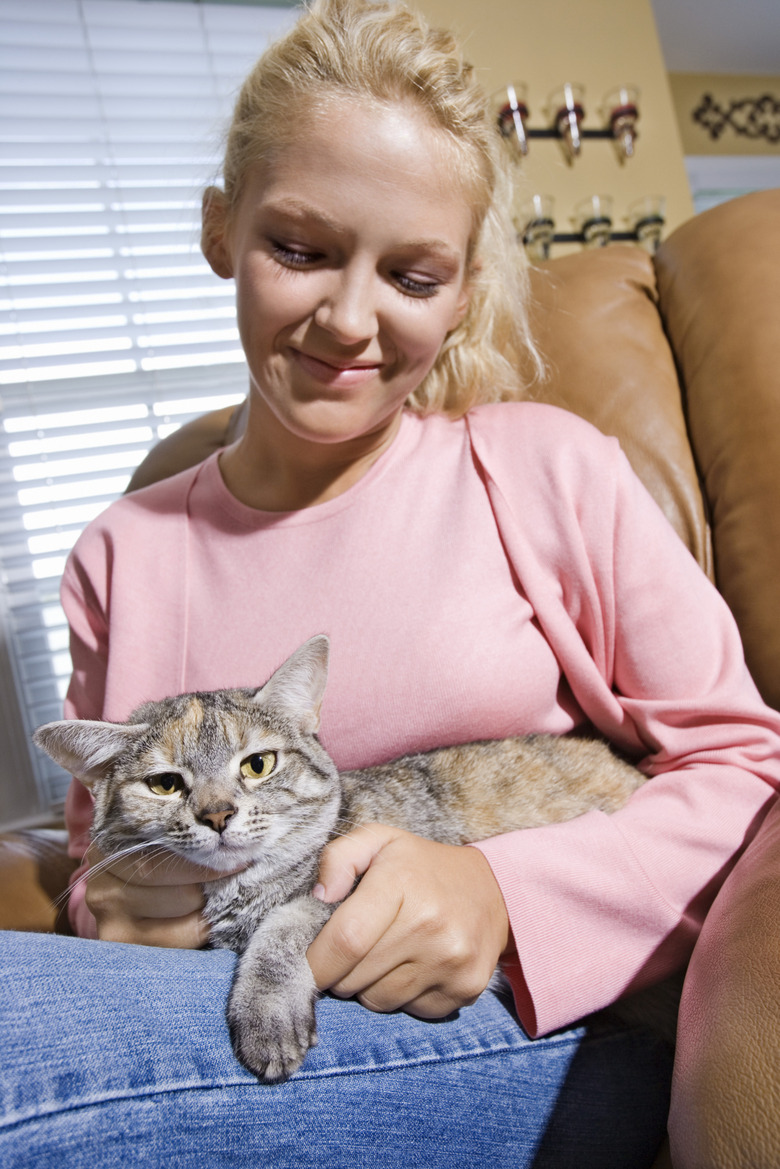Why Do Cats Knead Blankets?
We may receive a commission on purchases made from links.
Cuteness may earn compensation through affiliate links in this article.
When nursing from their mothers, kittens gently push in and out with alternative paws around their mother's teat, making a kneading motion to encourage the flow of milk. This behavior is normal and may continue into adulthood on other surfaces like plush blankets.
The Kneading Motion
The Kneading Motion
Kneading is sometimes called making biscuits because it looks like a cat is manipulating bread dough with her front paws. The cat will push down, usually into a soft surface like a blanket, with one paw at a time, alternating paws in a steady rhythm. Blankets provide an excellent medium for your cat to knead on because they are soft and fluffy, similar to her mother's belly.
Put a blanket in your lap for your kitty to sit on and see if she kneads it before settling down for a nap. The blanket will also protect your lap from those sharp claws she extends as she kneads. Foam-filled sleeping mats can offer even more distance between claws and your legs. K&H Pet Products Thermo-Kitty Mat has a dual-thermostat heater tucked into its foam interior for a cozy cuddle on winter days.
The Purpose of the Knead
The Purpose of the Knead
Although kittens knead to make nursing from their mother more productive, adult cats do so for a variety of reasons on soft surfaces.
- Cats may knead on a blanket before settling down to sleep to make themselves more comfortable and to unwind.
- Mother cats may knead on blankets to form them into a nest for their kittens.
- Wild felines knead on soft grasses and leaves outside to mold them into a comfortable sleeping surface.
- Cats have scent glands on their paws, which they use to mark people or places as their own while kneading.
- Female cats who aren't spayed may knead just prior to going into estrus to advertise that they are available to mate with male cats.
Kneading is Normal
Kneading is Normal
Kneading on blankets and other surfaces is normal, instinctive behavior for cats. Contrary to what some might believe, it is not a result of separating or weaning a kitten too early from her mother. The behavior is usually harmless unless the kitty starts to suckle on the blanket fabric and ingest it while kneading.
Cats who ingest nonfood objects like blankets could suffer from a condition known as pica. If you notice this type of behavior, get your cat to the vet for a checkup because ingesting fabrics can cause an intestinal blockage and may indicate an underlying medical issue. Make sure your cat has appropriate items to mouth, such as Kong Refillable Catnip Toys, which stand up to sharp kitty claws and teeth without coming apart.
Kneading vs. Destructive Scratching
Kneading vs. Destructive Scratching
Cats usually knead while sitting calmly on a blanket and may extend their claws into the fabric of the blanket while doing so. Scratching, on the other hand, can be destructive and usually occurs when the cat stretches her front paws out horizontally or vertically and pulls them back toward herself, with all claws extended to sharpen them.
- Although kneading is generally not destructive, if kitty's kneading is harming your heirloom blankets or quilts, discourage her from doing so by placing them out of reach.
- If you catch her in the act of kneading on something inappropriate, gently move her to a blanket that she's allowed to knead on.
- Cover heirloom items with aluminum foil or upside-down plastic carpet runners to discourage your kitty from kneading on them, because cats don't like the feel of these surfaces on their paws.
References
- LiveScience: Why Do Cats Knead?
- petMD: Why Do Cats Knead?
- The Humane Society of the United States: Cat Chat: Understanding Feline Language
- CatChannel.com: Why Do Cats Knead?
- Vetstreet: Why Does My Cat... Knead Me?
- American Society for the Prevention of Cruelty to Animals: Cats Who Suckle and Lick People
- The Humane Society of the United States: Cats: Destructive Scratching
- American Society for the Prevention of Cruelty to Animals: Compulsive Behavior in Cats
